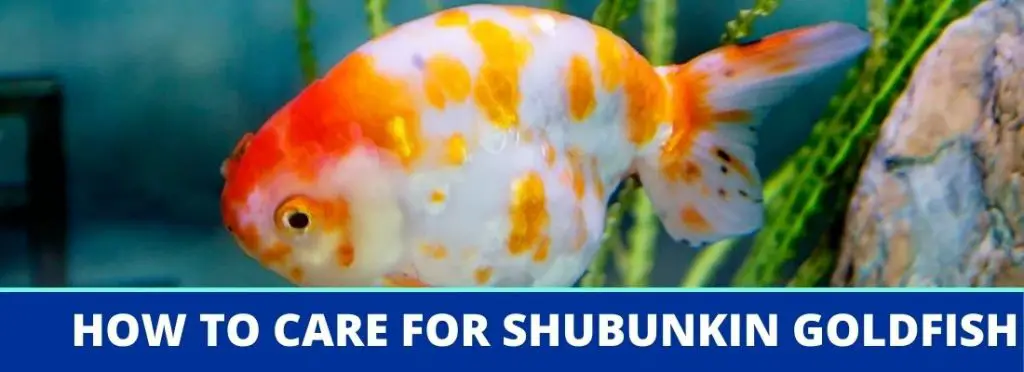Goldfish, of all species, has been one of the favorites among fishkeepers the world over. Shubunkin goldfish , however, are an exceptionally desirable variety.
Thanks to their unique coloration and perky personalities and the fact that they’re hardy fish – they’re one of the most popular goldfish options for people who know to look.
They’re easy to care for and they’re super fun and add a lot of color to any aquarium and work great as pond fish.
They do need specific care, however, and sadly goldfish are among some of the most neglected and poorly cared for species out there (with a close second found in bettas).
Author note: They should never be kept in tiny bowls and fed cheap fish flakes you find for $1. Instead, they need aquariums specially set up for them, fed proper foods, and kept in filtered tanks with proper water conditions maintained.
Quick Intro to Shubunkin Goldfish
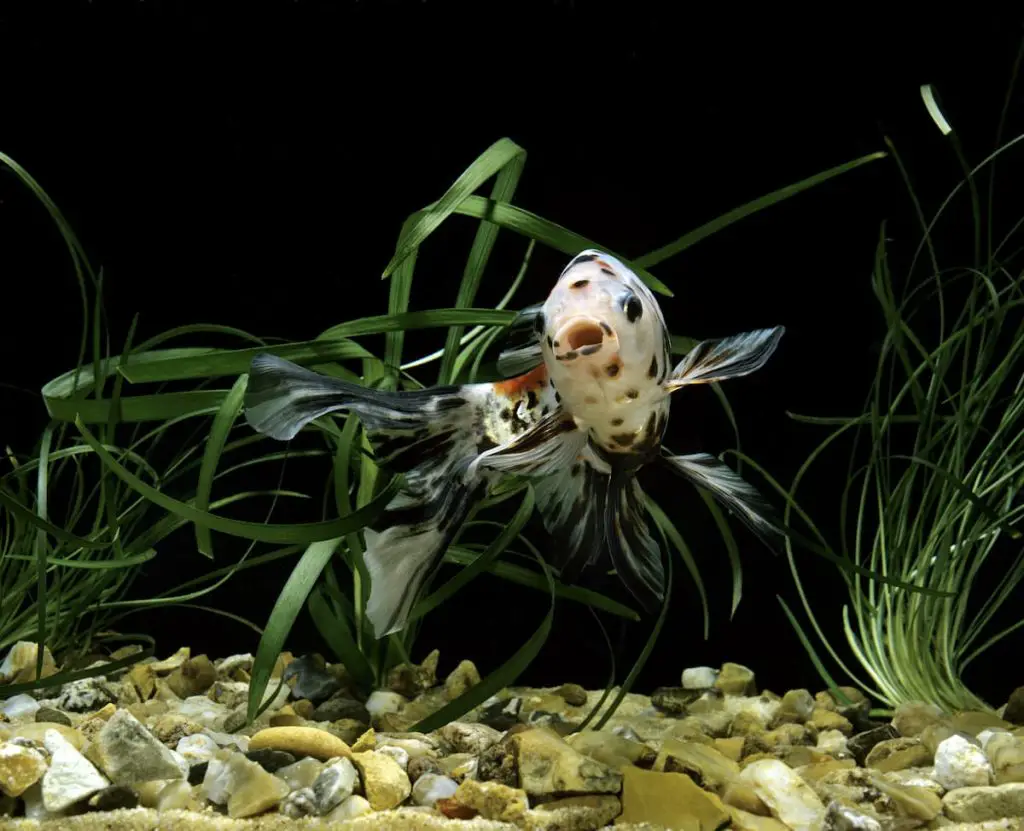
| Family: | Cyprinidae |
| Scientific Name: | Carassius auratus auratus |
| Common Names: | Shubunkin, Calico goldfish, Speckled goldfish, Harlequin goldfish, Coronation fish |
| Care Level: | Easy |
Natural Habitat, Identification, and Where to Buy Shubunkin
These beautiful fish go by many names, including Shubunkin, Calico, Speckled, Harlequin, and Coronation, thanks to their unique coloring, sleek shape, and beautiful, shining scales.
They’re part of the same freshwater fish family that carp and danios belong to.
Like koi, they do well in cooler water, but unlike koi, they’re a bit more affordable. They’re great for indoor aquariums, or indoor or outdoor ponds. Their bright colors and unique patterns draw attention wherever they swim.
This particular goldfish is the result of very specific breeding. They originated in the Prussian carp and it’s believed that they were specially bred in Japan around 1900.
Author note: They’re available widely today, but they aren’t all recognized officially as shubunkin by breeders.
Types of Shubunkin Goldfish
There are three types of shubunkin goldfish available around the world. Research shows that one variety is the original, the other two are variations.
The London Shubunkin Goldfish
London shubunkin will have calico patterns, varying in color combinations. They have thicker bodies than other shubunkins, making them easier to identify, and have round fins.
The Bristol Shubunkin Goldfish
Bristol shubunkin are easier to identify than others due to its tail. The fins are huge, bifurcated, and pointed, and appear to form the better “B” – the other varieties of shubunkin don’t. They have thinner bodies and resemble comet goldfish.
The American Shubunkin Goldfish
The tail on the American shubunkin is the main difference from other varieties, as well. They’re much longer and more pointed on them, and their body types are much thinner. They’re mistake as common calico goldfish at times.
Coloration Types of Shubunkin
There are also multiple coloration types among these coldwater fish.
Most shubunkin that you’ll find at pet stores include calico shubunkins, with patches of black, red, and white. These are usually the “shiny” goldfish among the others.
Midnight shubunkin are mostly black with hints of white.
Black opal shubunkin look very similar with more pronounced black shades.
Ghost Bristol shubunkins are known as pinkies with no metallic scales and they have pink gills and are white overall in color. Imperial shubunkins are solid red with some shiny scales mixed in with the others.
Sanke gold shubunkins are bright white and not blue with pops of black and red.
Finally, the sky blue shubunkin has no red, a matte base with a sprinkling of metallic scales, and occasional black markings and pink gills.
Optimal Water Conditions for Shubunkin Goldfish
| Water Temperature: | 65 – 72° F |
| Water Flow Rate: | Moderate |
| pH: | 6.0 to 8.0 |
| Water Hardness: | 5 – 19 dGH |
Tank Setup
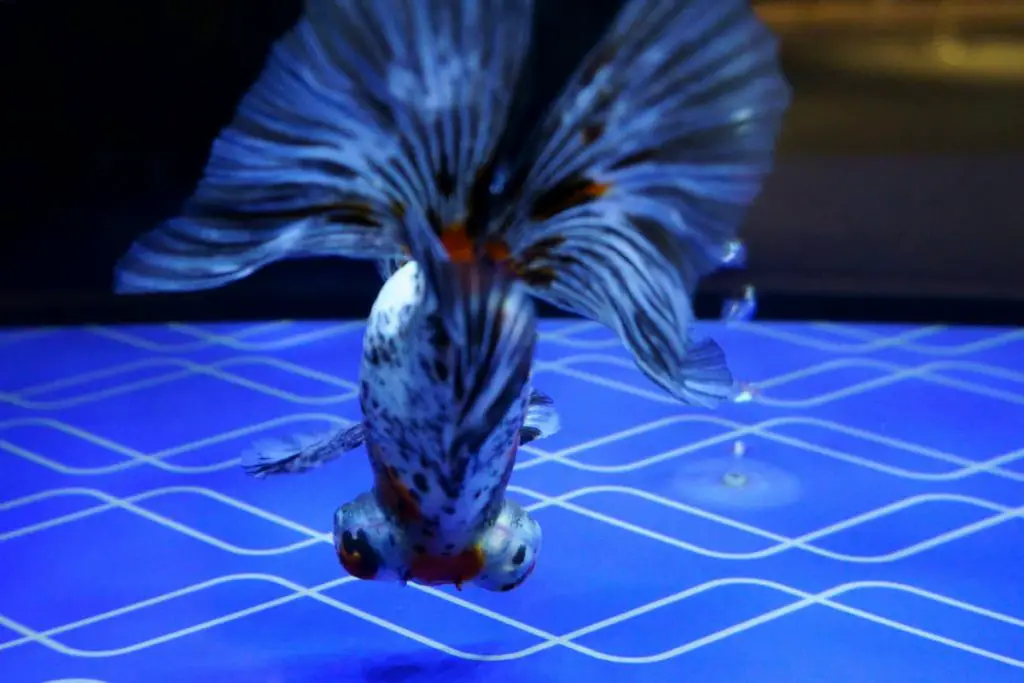
| Minimum Tank Size: | 75 gallon gallon tank |
| Optimal Tank Size: | 100 gallons |
| Optimal Tank Shape: | Long, rectangular aquariums are fine |
| Recommended Filter Type: | Powerful filtration system |
Shubunkin can do well in either aquariums or ponds. Goldfish are naturally found in slow-moving lakes, rivers, ponds, or even ditches, so they do well in similar settings.
Backyard ponds or sculpted goldfish ponds, for example, that have been heavily planted are great situations for these fish.
These fish can live up to 30 years and grow up to 12-inches long. The conditions in their aquariums or ponds have to be near perfect, though, for this to happen, with the right amount of space, the right food, and well-kept water parameters.
To keep your goldfish healthy, they need to have plenty of room for swimming. One of the biggest disservices done to goldfish, bettas, and others has been through this misinformation about goldfish doing all right in tiny fishbowls.
Some species of goldfish do all in smaller tanks (though never that tiny bowl), but shubunkins actually require a large aquarium. They need 75+ gallons per fish or pair, or ideally, 100+ gallons.
They need low to moderate water movement as well – emulating that natural habitat they come from in the wild. They also need a fair amount of light, stable water conditions, and proper temperatures.
Keep the water between 65 and 72 degrees, with a pH level of 6.0 to 8.0, and water hardness between 5 and 19.
Another myth in the aquarist world is that goldfish don’t need filters. This is absolutely and completely wrong.
These fish are incredibly messy fish and they need not just clean water but a powerful, good filtration system to keep that water healthy and healthy for them.
Since these goldfish are fast and active swimmers, they need lots of room for swimming – so though it may be tempting to add lots of decorations, they do best with plenty of open space instead.
Top tip: They do best in a long tank for better aeration and oxygen exchange.
Creating the Landscape
Shubunkin, like most goldfish species, are pretty “flexible” in their environmental needs. They do require certain parameters met, but they’re reasonably easy-going otherwise, which is part of why they’re so popular among aquarists.
They don’t mind most substrates, though they shouldn’t have sand or tiny gravel – as they’ll eat these by accident at times – and ideally medium-sized gravel is best.
They do well with moderate lighting and some plants, though they also eat a lot of plants. They do best with plants they won’t uproot or eat. A lot of folks choose silk plants instead of live plants.
They do well with smooth rocks and treated driftwood, though you should keep these to a minimum as well. Again, these fish need a lot of swimming space.
| Best Plants: | Java moss, anacharis, hornwort, anubias, crypts, Amazon sword, pothos, water sprite |
| Best Lighting: | Moderate |
| Best Decorations: | Medium-sized gravel, driftwood, artificial plants or live plants, rocks |
| Decorations to Avoid: | Anything with jagged edges and anything that overcrowds the open swimming space, small gravel, and sand. |
Physiological Considerations
| Size: | 12 inches |
| Lifespan: | 15 years |
| Temperament: | Peaceful |
| Preferred Tank Region: | Any |
| Scale Thickness: | No particular concerns |
| Gill Considerations: | Usual gill concerns for goldfish. Keep their tanks clean to keep them healthy and happy. |
| Swimbladder Considerations: | Goldfish tend to be susceptible to swim bladder conditions. Avoid overfeeding them and keep their tanks clean to keep them safe. |
| Fin Shape Considerations: | Standard concerns for fins – keep jagged edges away and keep fin nippers stocked separately. |
Both Bristol and American shubunkin have tails that continue growing in length as they age (i.e. after they reach full maturity, their tails still grow).
The length ultimately depends on genetics, of course, but the long fins can pose a potential issue, especially if there are any fin nippers around.
The fins drag along objects at the bottom of the tank and make have abrasions from the interactions.
Shubunkin have speckled coloring – thus the calico term – combing any mix of red, orange, white, black, yellow, or blue.
The blue hues are some of what make this goldfish so unique and the more blue coloring, the rarer the fish and therefore the more expensive.
The head of the shubunkin is usually wide but short, their bodies in a smooth taper, with an expansive dorsal fin that stands erect.
Society
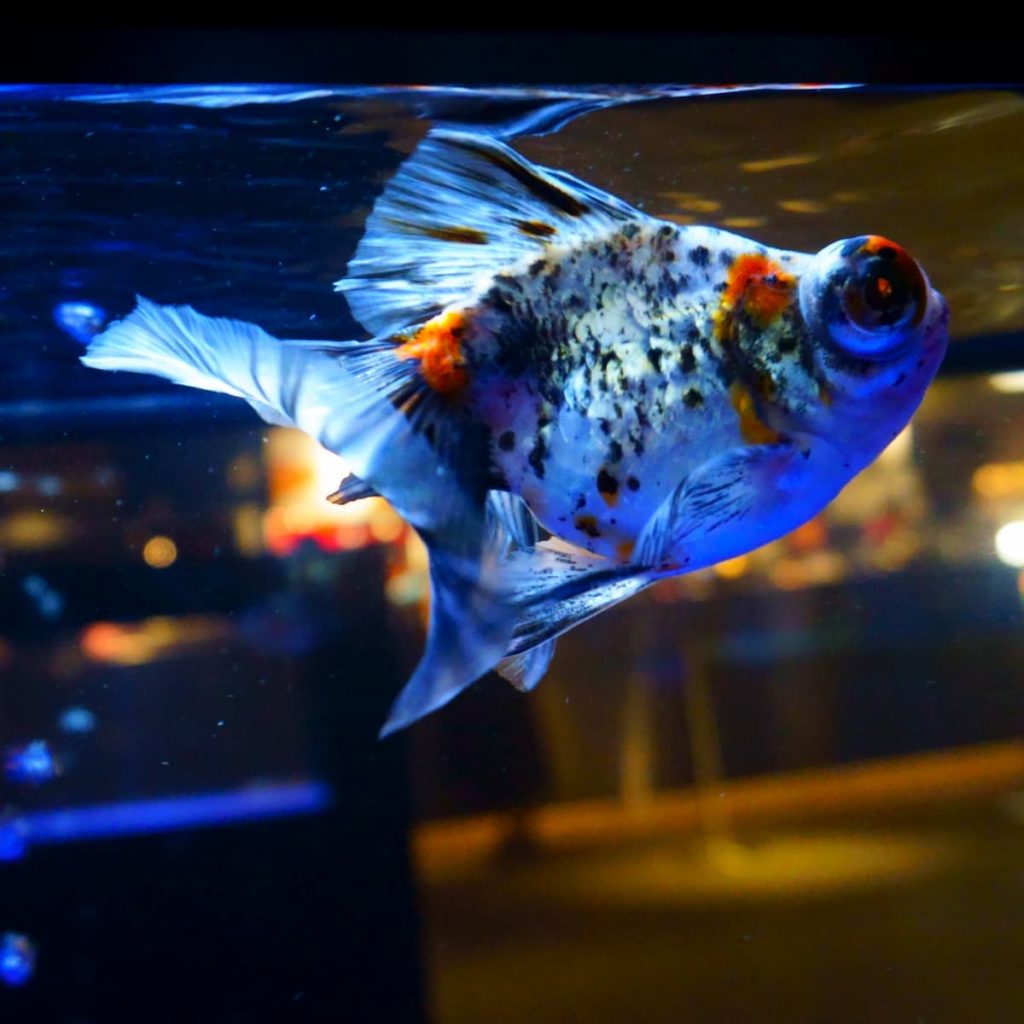
These large goldfish are unusually social fish that do really well in community tanks and ponds. They should be housed with other fast swimming fish, though, to ensure nobody’s chased around too much.
They make use of all parts of the fish tank, but they will often congregate at the bottom of the tank, gobbling up left over food, detritus, and other “goodies.”
They tend to steal food from other fish, as well, so they’re not just scavengers – they’re thieves. This is all the more reason it’s important to keep them with other fast-moving fish who can keep up with them.
They do well with a variety of species, including guppies, tetras, and killifish. You should avoid aggressive fish, though, like cichlids and tiger barbs.
The fish who make good shubunkin tank mates include:
- Amano shrimp
- Guppies
- Most tetra species
- Mystery snails
- Fancy goldfish
- Common goldfish
- Comet goldfish
- Koi
- Killifish
- Glass and Pictus catfish
- Cherry barbs
- Chinese blue bitterling
- Northern redbelly dace
Gender, Breeding, and Reproductive Considerations of Shubunkin
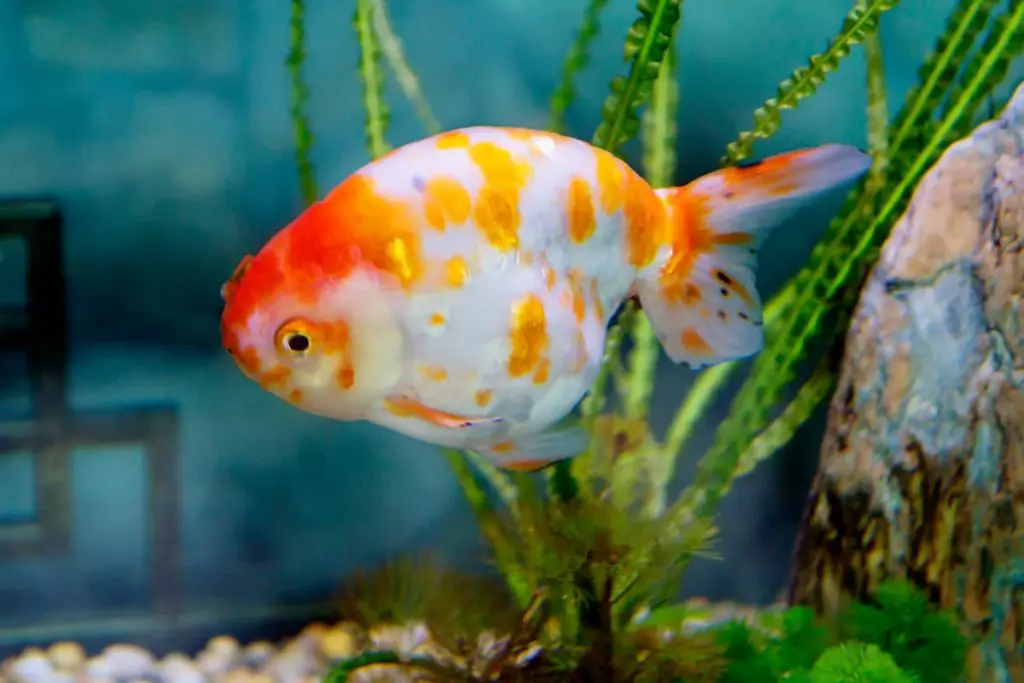
Male and female shubunkin goldfish generally look pretty much the same. It’s hard to tell them apart for breeding purposes. However, you can observe the fish from above to get an idea.
The females have a wider, rounder body than males. And during mating season (springtime), the males develop white pimple-looking things on their gill covers. These are called tubercles or breeding stars.
These goldfish breed in groups of four or five and prefer to shoal in larger groups. So, they’ll spawn in the right conditions, so making the temperature right and placing them in a breeding tank. They won’t need other help.
Put plants in the breeding tank to help the fish breed and catch the eggs as they’re laid. Then adjust the temperature to around 60 degrees and increase the temperature daily by 2 to 3 degrees until you reach 72 degrees.
Give them lots of high protein foods – think brine shrimp and bloodworms – and keep the tank clear and remove excess food to prevent overfeeding.
You’ll see the males start to chase the females playfully. Their colors will intensify. Then, the males will push the females against the plants, which causes the females to release eggs for the males to fertilize.
Spawning lasts a few hours, producing up to 10,000 eggs. When the spawning is complete, the parents will eat the eggs they find, so they should be removed to the normal tank immediately.
Eggs take about 7 days to hatch. Feed the fry some brine shrimp as they swim around in there. Once they reach one-inch in length, they’re safe to be moved into the adult tank.
Nutritional Needs
Goldfish are known to be fish with a bottomless appetite that will eat anything offered, and even things that you may not intend to be food.
The downside of such a huge appetite is that it becomes very easy for the fish to be overfed. An overfed fish can easily develop health problems.
Besides whatever food you give them, this species will go hunting for whatever else they can find. They are known to actively search the middle and bottom of the water for anything they can fit in their mouth.
This list includes detritus, insects, smaller crustaceans, and plant material.
The plus side to having scavenger fish always looking for food is that they will do most of the tank cleaning for you.
A downside to their constant search for food is that they are known to both uproot and eat any plants that you have put in your aquarium.
Their habit of eating aquarium plants is why some use lilies or fast-growing plants that can keep up with the goldfish.
This fish species was created in captivity. Due to this, there is not a diet from nature that can be replicated.
However, due to the fish’s ancestors being carp, probably, the fish ancestor would happily eat everything from plant matter to small insects.
When it comes to creating a diet for your fish, most people like to use pellets to help ensure the fish will have what they need. Feeding the fish twice a day with flakes or pellets is normally enough.
Feeding should be no longer than two minutes and include feeding them as much food as they can eat in that window.
Top tip: After you finish feeding it is important to remove any leftover food so that your fish doesn’t continue to gorge itself later or the food starts to rot and mess with the water chemistry.
Author note: If you keep other fish in the tank that aren’t as fast as your shubunkins, you should first feed the shubunkins on one side of the tank, then feed the other fish on the other side. This will allow them a little time to get their own meal in without the shubunkins stealing from them.
| Best Sustenance Food Type: | A high-quality flake or pellet food. |
| Additional Food For Optimal Health: | A mixture of live or frozen foods such as blood worms, tubifex worms, brine shrimp, and daphnia. |
| Special Foods and Considerations for Best Color and Growth: | N/A |
| When and How Often to Feed Fish Based on Life Cycle: | Feeding should be twice a day for two minutes and include as much pellets and flakes as the fish can eat. |
Common Diseases and How to Avoid and Treat Them
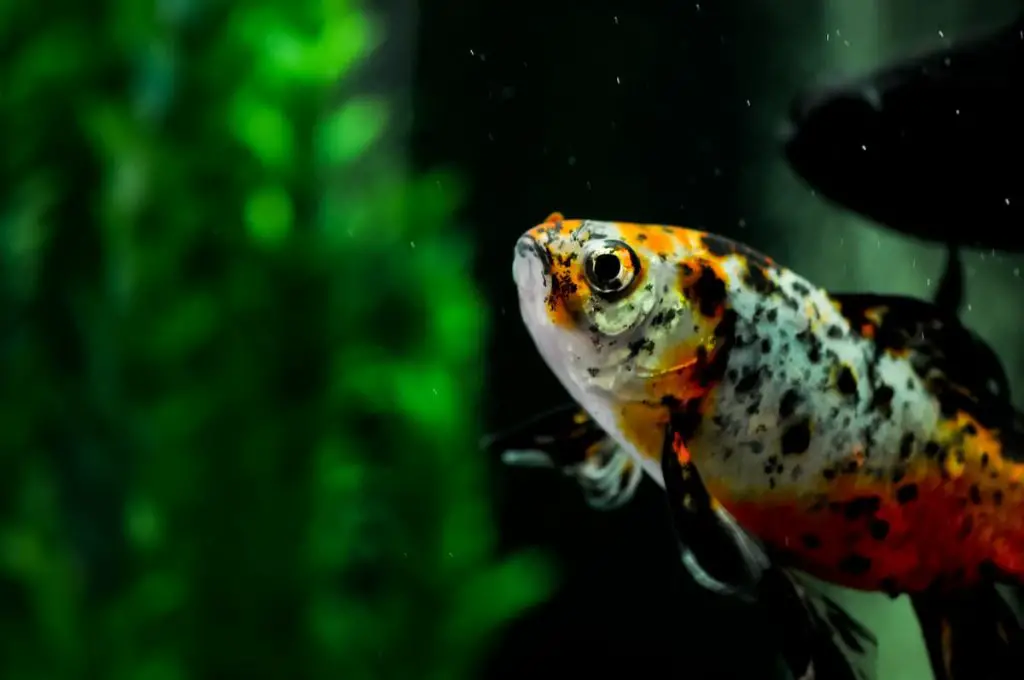
Shubunkin is like Goldfish in the hat they are a very messy fish. Due to the mess, they require to have cleanings and full water changes more often than other fish.
While this can be a time-consuming process it is important for keeping your fish healthy and happy.
If the water in the fish tank isn’t kept clean, then your fish run the risk of becoming infected with parasites or developing a bacterial infection.
There are several factors to consider like tank size and the number of fish but the suggested norm is to change a minimum of 25% of the tank’s water every week.
It is important to keep a close eye on your fish’s skin. There is a specific infection called Goldfish Ich, which is the most common disease that can be found in aquariums.
Ich is a parasite that presents itself as white dots or spots on the fish’s skin. The first indication something is wrong is that the fish will try to scratch its skin on various objects in the tank.
If the disease is left untreated the white dots can quickly worsen. Over time their white wounds will become infected by bacteria or fungus. The fish will stop moving and eventually die.
While this disease can be scary it is treatable.
Once you have identified a sick fish it is important to isolate them from other fish to help limit the sickness spreading. Some antibiotics can be purchased and put into the isolation tank to help the fish heal.
Another common illness to watch out for is swim bladder disease. If you see your fish swimming sideways, bloated and floating, struggling with buoyancy, it is important to start treatment.
The treatment involves isolating the affected fish, adding antibiotics to the water ceasing feeding for a few days, and increasing the temperature of the tank water.
After several days the fish needs to be fed a fiber-rich diet to help it with digesting.
One last thing to watch out for is an infection called fin rot. This can be caused by a fish that was nipped or damaged its fin on a rock and the wound became infected.
The fish should be isolated and given antibiotics. Not treating will eventually lead to death.
| Best Antibiotics: | Over-the-counter antibiotics suffice, if the problem continues consult a vet. |
| Treatments to Avoid: | N/A |
| Food Recommendations When Sick: | Fresh and or live foods are best due to their nutritional value. |
| Hospital Tank or Isolation Within the Community Tank: | When ill, Shubunkin goldfish should be kept separate in a hospital tank. |
3 Facts About Shubunkin Goldfish
- Shubunkin goldfish have a unique variety of scales that will either appear in calico patterns, or in blue metallic looks, depending on their specific genetics.
- The blue coloring of Shubunkin goldfish comes from the black pigment in their bodies. Their genetics determine if their blue scales appear metallic or matte. Only one type of scale (nacreous) is actually accepted by Shubunkin breed standards.
- Shubunkin goldfish don’t have teeth like other creatures. Instead, their teeth are in the backs of their throats (known as pharyngeal teeth).
FAQs on Shubunkin Goldfish
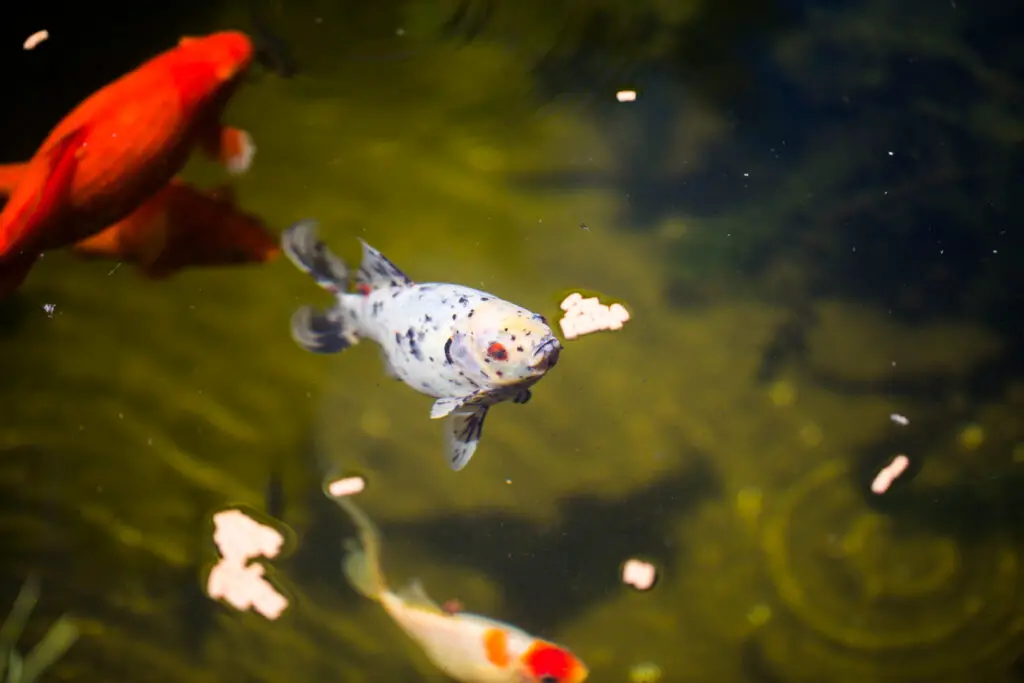
What tanks do Shubunkin goldfish do best in?
Shubunkin goldfish make excellent fish for both beginners and advanced aquarists.
They can fit into many community tanks as well as outdoor ponds.
There are plenty of fish that will work well with them and keeping this fish will provide you with an energetic and active species.
No matter your experience level, you can find a benefit to these colorful and hardy fish. There is little to watch out for except for keeping the water conditions stable.
They add so much to your tank and can even be additions to ponds as an alternative to koi. If you have a large enough tank or pond for these fish, then they could be the fish for you.
How old do shubunkin typically live to be?
Shubunkin can happily live into their mid-teens, as long as they are well-cared for.
The oldest shubunkin goldfish age on record is 20 years old, though, so, who knows? Maybe your shubunkin will outlast them all!
Do Shubunkin goldfish do well as pond fish?
Shubunkins are often kept in the stead of koi for outdoor and indoor ponds. They’re typically less expensive than koi, which make them a great option for this plan.
Do shubunkins have short term memory issues like other goldfish?
Contrary to the urban myth, goldfish actually have pretty lengthy memory capabilities. They recognize their keepers, they memorize their feeding schedules, and, if you’re lucky, they’ll even learn to do tricks for you.
